Conference to introduce results from the 100-School Networking Project (Phase
II)
Elementary school meeting
Learning to Use a Networking System in a Friendly Atmosphere
Yuichi Fujimura, Kounan Elementary School
1. Introduction
- (1) Learning and living together
- Despite a curriculum that emphasizes the unique traits of each of our students,
we have recently witnessed several serious incidents, including one in which
a boy wielding a knife attacked several other students. Prompted by such sobering
occurrences, we have undertaken a review of our educational policies in an
effort to discover what, if anything, is lacking in the education of our children.
As a result of such reflection, we have chosen to stress the importance of
co-existing and the importance of learning and living together.
- We have also decided to teach children about networking systems in ways
that allow children to learn through relationships with other people, rather
than through experience merely with computers.
This idea is the result of experience distilled from three years of networking
through Internet use by both teachers and students. The Internet tends to
emphasize the connection of person to person, rather than computer to computer,
so that everyone on the network is both student and teacher.
- (2) A learning cycle, experience-information-experience
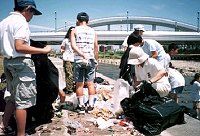
To learn, our students require more than the mere exchange of information
over a network. Since experience is the most important educational tool in
teaching children, we've created a cycle in which children can experience
something, acquire some information, then resume their experience in order
to take advantage of both learning styles.
As shown in the picture (of clean-up efforts on the Toyohira River, which
runs by our school), to learn about global environmental problems, children
start by thinking about local environmental problems and doing what they can
at the local level.
2. International environmental education project
(1) The garbage project
- Joint research on environmental destruction resulting from litter and improper
waste handling, with students from around the world and Japanese traveling
abroad
- Working with students from around the world, children at our school study
the environmental damage produced by waste.
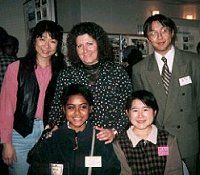 In FY 1997,
we began by picking up garbage along the Zenibako coast in Otaru city, where
the children often go to swim. The amount collected with help from the owners
of small seaside inns was much greater than expected by the children. Much
of this the collected garbage was clearly thrown away by other children. We
found garbage originating from places as far away as Nagano, and even PET
bottles and vinyl bags from Russia and Korea, making concrete the global nature
of the waste disposal problem, which ignores international boundaries. Our
experiences made it vivid how garbage collects from towns into streams, then
from streams to rivers, and from rivers to the sea. Our students asked students
in Micronesia, the US, Germany, and Belarus (ex-Soviet Union) to study local
littering and waste disposal in their own countries. (The picture shows several
project supporters, including *Daria* from Micronesia, *Sari*, a teacher from
France, and Takako Takano, a Japanese adventurer)
In FY 1997,
we began by picking up garbage along the Zenibako coast in Otaru city, where
the children often go to swim. The amount collected with help from the owners
of small seaside inns was much greater than expected by the children. Much
of this the collected garbage was clearly thrown away by other children. We
found garbage originating from places as far away as Nagano, and even PET
bottles and vinyl bags from Russia and Korea, making concrete the global nature
of the waste disposal problem, which ignores international boundaries. Our
experiences made it vivid how garbage collects from towns into streams, then
from streams to rivers, and from rivers to the sea. Our students asked students
in Micronesia, the US, Germany, and Belarus (ex-Soviet Union) to study local
littering and waste disposal in their own countries. (The picture shows several
project supporters, including *Daria* from Micronesia, *Sari*, a teacher from
France, and Takako Takano, a Japanese adventurer)
Via the Internet, we learned about nature in the US and China, and the effects
of litter and waste on the environment from the Sekiguchi family, who walked
across America, and a group that trekked across China as part of a modern-day
mission to the Tang Dynasty.
We learned that a significant amount of garbage from Japan washes ashore in
places such as Micronesia and Hawaii, and that the environmental damage resulting
from littering and waste disposal is increasing the world over, not merely
in China, Belarus, or Russia.
- Cleaning projects and recycling activities with students from all over the
world
- After learning about the current state of littering and waste disposal,
we discussed the issues with students from around the world, including satellite
exchanges with students from Micronesia—in which, much to our surprise, a Micronesian
student told of finding a package of instant noodles that had floated all
the way from Japan. We decided to volunteer to help clean up the environment
and to start recycling projects. Schools from various areas in Japan, including
the Yamagata and Okayama prefectures, joined in our efforts and activities,
encouraging our students.
- Learning from people we've met via the Internet
- This year, our students had the chance to meet the people we'd come to know
through the Internet, from whom we learned about environmental problems, nature,
and effective recycling. Professor Matogawa, an astrophysicist from the Institute
of Space and Astronautical Science who has reported on the Mars Path Finder
mission visited and talked about garbage in space, the importance of life,
the earth, and protecting the global environment. Mr. and Mrs. Sekiguchi visited
and talked about nature in America, sharing some of their adventurous experiences
with us. Children from Belarus who were exposed to radiation from Chernobyl
taught us that environmental problems can lead to injury and death, but that
people can also have the strength to overcome tragedy and once again lead
happy lives. These students also reported on recycling and current environmental
problems in Belarus and Russia. And Neal, from Earth Shop, taught us the importance
of recycling and some great ways to use recycled products.
What we learn from people we meet via the Internet often leads to meeting
them in person, allowing us to learn even more.
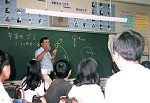
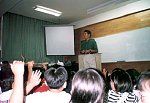
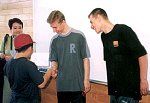
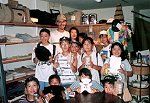
- Learning why used paper recycling is no longer viable by talking with various
adults throughout Japan
- After collecting a certain about of recycled paper, our students went to
a dealer, only to discover that he had recently closed his business. Other
businesses, when we approached, told us they would not take used paper. In
some cases, we were told we could leave our paper—but only if we paid.
Soon, frustrated and puzzled by our experiences, we started looking for explanations.
In only two days, our public appeal for cooperation, made via the Internet,
returned more than thirty pieces of e-mail from consumers, consumers' groups,
the government, people dealing in used paper, manufacturers, and environmental
think tanks from all over Japan. The information they provided and their encouraging
words moved our students deeply. The warmth of these responses motivated them
to do more in-depth research into the reasons for this problem. As a result,
they realized that they needed to change their idea of recycling, from just
collecting used products to effectively using recycled products. We still
keep in touch with people we've gotten to know during this project, which
expands our human network even further.
3. Through the Northern Provinces Information Corner
- We've established two home pages on the Internet. Northern Provinces Information
Corner introduces the unique lifestyles and culture of the northern provinces
so that other schools can use this information in the "People's lifestyles
in different areas of Japan" segment of their social studies classes.
Meanwhile, the Northern Provinces Information Service answers children's questions
from all over Japan. Many children have looked up these pages for responses
to questions, or to set up some type of interactive study. Through these home
pages, children have been able to study together and to ask each other questions:
"This is what it's like in Sapporo. What's it like there?"
4. Running "Kounan Wonderland," Japan's largest link directory for elementary
school students organized by subject and field
- Our school runs "Kounan Wonderland," Japan's largest link directory
for elementary school students. It links over 800 sites, organized by subject
and field, so that children can use this information for study and recreation.
We've had talks and exchanged information with people who have their own home
pages, and our students have learned a lot from such experiences.
5. Conclusion
- Learning to use a networking system in a friendly atmosphere is a
wonderful way to teach children the importance of human relationships, and
the importance of living and working together. Through networks, we meet people
we don't meet in our everyday lives and open up our classroom to the outside
world, reaping all the educational benefits that are to be found out there.
But such learning must be supported by teachers.
 Conference to introduce results from the 100-School Networking Project (Phase II)
Conference to introduce results from the 100-School Networking Project (Phase II)

 In FY 1997,
we began by picking up garbage along the Zenibako coast in Otaru city, where
the children often go to swim. The amount collected with help from the owners
of small seaside inns was much greater than expected by the children. Much
of this the collected garbage was clearly thrown away by other children. We
found garbage originating from places as far away as Nagano, and even PET
bottles and vinyl bags from Russia and Korea, making concrete the global nature
of the waste disposal problem, which ignores international boundaries. Our
experiences made it vivid how garbage collects from towns into streams, then
from streams to rivers, and from rivers to the sea. Our students asked students
in Micronesia, the US, Germany, and Belarus (ex-Soviet Union) to study local
littering and waste disposal in their own countries. (The picture shows several
project supporters, including *Daria* from Micronesia, *Sari*, a teacher from
France, and Takako Takano, a Japanese adventurer)
In FY 1997,
we began by picking up garbage along the Zenibako coast in Otaru city, where
the children often go to swim. The amount collected with help from the owners
of small seaside inns was much greater than expected by the children. Much
of this the collected garbage was clearly thrown away by other children. We
found garbage originating from places as far away as Nagano, and even PET
bottles and vinyl bags from Russia and Korea, making concrete the global nature
of the waste disposal problem, which ignores international boundaries. Our
experiences made it vivid how garbage collects from towns into streams, then
from streams to rivers, and from rivers to the sea. Our students asked students
in Micronesia, the US, Germany, and Belarus (ex-Soviet Union) to study local
littering and waste disposal in their own countries. (The picture shows several
project supporters, including *Daria* from Micronesia, *Sari*, a teacher from
France, and Takako Takano, a Japanese adventurer)



 Conference to introduce results from the 100-School Networking Project (Phase II)
Conference to introduce results from the 100-School Networking Project (Phase II)